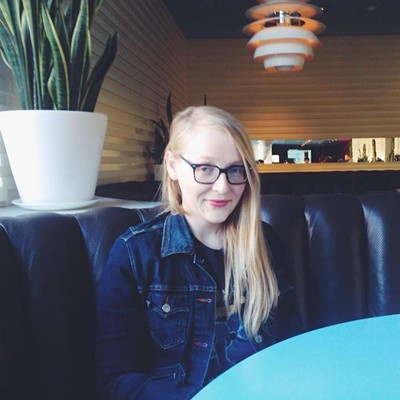Every other year, New Times puts the spotlight on Phoenix's creative forces — painters, dancers, designers, and actors. Leading up to the release of Best of Phoenix, we're taking a closer look at 100 more. Welcome to the 2016 edition of 100 Creatives. Up today is 77. Shaliyah Ben.
It's not that Shaliyah Ben ended up working at the Heard Museum. It's that she always has.
"This is a funny story," Ben says. "I actually grew up in the Heard Museum."
When Ben was a toddler, she landed her first job as the cover girl for a brochure for the Central Phoenix institution. "From there," she says, "I received another job as gallery attendant at around 4 or 5 years old to stay out of trouble."
This was all while Ben's mother was undergoing training to become the first, as timing would have it, American Indian woman to serve as a guide at the Heard.
The connection stuck. As a teen, she followed in her mother's footsteps and became a student guide. Then, in college, she worked in the curatorial department.
Now 32, Ben's still hard at work in the Southwest's premier institution for Native artifacts and contemporary art. She's the education program and outreach manager. But, she explains, "what I really do is manage and run the K through 12th grade learning experience at the Heard Museum. If you have a fourth grader or any other student in K through 12th grade, there is a chance I’ve taught them!"
For the Phoenix-based educator who was born in Shiprock, New Mexico, on the Navajo Nation, work is more than just work. It's a long-term relationship. "It is out of reverence for the collections, the art, and the pieces that we have in the collections that are physical extensions of our cultures," she says. "They need love and someone to care for them."
It's Ben's dedication to this idea that's kept her engaged with the museum for nearly three decades.
Recently, she curated and opened a kids' space in the museum called It’s Your Turn: A HOME Studio, which features activities that align with themes in the Heard's permanent exhibit, "Home: Native People in the Southwest." "I was searching out a way to expand on the learning for students; many of them need more than a verbal 45-minute tour," she says. "They need the activity to have a well-rounded learning experience."
This new space offers precisely that — and furthers her mission to help others connect with the Heard's offerings.
"A blanket is not just a blanket and a pot is not just a pot and so on," she says. "Each piece has a story and history and perhaps belonged to someone that loved it dearly. I like to think that I care for these pieces and honor them in the work I do by teaching about them."
I came to Phoenix with two young Navajo artists in the early '80s.
I make art a priority in my life because its creation is the first and most natural human reaction to the world there is. From the time we were able to comprehend our existence, we have had the desire to create and express ourselves. I really believe that we [search] for a way to feel understood as humans, and art provides a vehicle for that understanding. In my work, I show that for indigenous peoples it represents so much more. For many years, it was the only “appropriate” means of being who you are. Today, we celebrate the richness of our heritages; we also challenge institutions that attempted to “box us” in and use art to make very powerful statements and to heal.
I'm most productive when I know my work is being appreciated and enjoyed.
My inspiration wall is full of works of art by forgotten artists; their legacies are the blueprints of our inspiration.
The art of teaching is a major driving force for me; seeing students construct and demonstrate that they understand new principles/concepts through art is fascinating. My late grandmother Elaine Weston taught me how to engage students and how to use empathy to become the best teacher possible.
Good work should always not feel like work, should be fun, and should be something that you learn from.
The Phoenix creative scene could use more opportunities for young American Indian artists! I also see a need for adult Phoenicians to raise baby Phoenicians to be literate in the arts, perhaps even start collecting at a young age. We live in the most materialistic society on the planet. Collecting art is a way to pass on bits of you to your next generation in the most beautiful way.
The 2016 Creatives so far:
100. Nicole Olson
99. Andrew Pielage
98. Jessica Rowe
97. Danny Neumann
96. Beth Cato
95. Jessie Balli
94. Ron May
93. Leonor Aispuro
92. Sarah Waite
91. Christina "Xappa" Franco
90. Christian Adame
89. Tara Sharpe
88. Patricia Sannit
87. Brian Klein
86. Dennita Sewell
85. Garth Johnson
84. Charissa Lucille
83. Ryan Downey
82. Samantha Thompson
81. Cherie Buck-Hutchison
80. Freddie Paull
79. Jennifer Campbell
78. Dwayne Hartford
[
{
"name": "Air - MediumRectangle - Inline Content - Mobile Display Size",
"component": "18478561",
"insertPoint": "2",
"requiredCountToDisplay": "2"
},{
"name": "Editor Picks",
"component": "16759093",
"insertPoint": "4",
"requiredCountToDisplay": "1"
},{
"name": "Inline Links",
"component": "17980324",
"insertPoint": "8th",
"startingPoint": 8,
"requiredCountToDisplay": "7",
"maxInsertions": 25
},{
"name": "Air - MediumRectangle - Combo - Inline Content",
"component": "16759092",
"insertPoint": "8th",
"startingPoint": 8,
"requiredCountToDisplay": "7",
"maxInsertions": 25
},{
"name": "Inline Links",
"component": "17980324",
"insertPoint": "8th",
"startingPoint": 12,
"requiredCountToDisplay": "11",
"maxInsertions": 24
},{
"name": "Air - Leaderboard Tower - Combo - Inline Content",
"component": "16759094",
"insertPoint": "8th",
"startingPoint": 12,
"requiredCountToDisplay": "11",
"maxInsertions": 24
}
]











